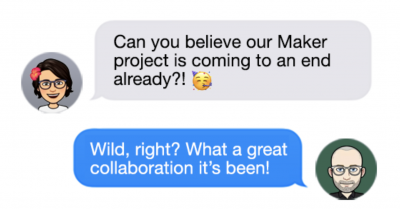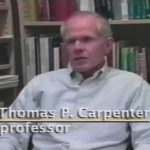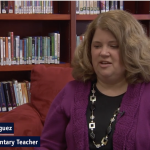Integrating the Project into a Course:
Three Teacher-Educators Share Their Experiences
Wondering what it might be like to try and integrate a Making Project into your own coursework as a teacher-educator (TE) ? Here, three TEs share their own experiences doing just that. On this page you can find:
- Eileen’s Connections: Videos of real experiences and student examples from one TE.
- Steven’s Syllabus: A TE’s detailed course-integration plan.
- Mark’s Reflections: A transcript and audio interview with a third TE discussing his preparations and trepidations as he integrated the project into his course during the pandemic.
- A Chat with Project Co-Directors: A behind-the-scenes conversation between our co-directors as they reflect on their experiences.

Eileen talks about the opportunities and possibilities that can happen at the intersection of a Teacher-Maker Project and course lessons in three videos.

Steven helps prospective users of the curriculum imagine how it can be integrated into an existing course by sharing the syllabus from his specialized content and methods course for elementary teachers.

Mark is a teacher-educator not affiliated with the project. He tested the curriculum in his own course and shares some of his reflections below.

The project’s directors reflect on their experiences through chat here.
Eileen Fernández, PhD
Making Experience: Connecting a Customary Lesson to Manipulatives
In this first video, Eileen introduces her own experience of the project, and talks about connecting a customary lesson to manipulatives in progress.
Making Experience: Designing New Lessons
In this second video, Eileen talks about designing new lesson(s) that deliberately connect up to manipulatives in progress!
Making Experience: Modifying Customary Lessons
In this third video, Eileen talks about her own experience modifying customary lessons for teachers' insights and questions!
Steven Greenstein, PhD
Integrating a Making Experience into Mathematics Teacher Preparation Coursework
Our research has documented prospective elementary teachers’ learning of mathematics, pedagogy, and design through their Making experience and the coursework that informed it. Furthermore, we found that the development of their identities as teachers of mathematics was as central to their learning to teach mathematics as their learning of these three interrelated domains.
Looking across PMTs’ design experiences, features of a pedagogy in progress were implicated, such as the following: a commitment to an inquiry pedagogy informed by constructivist principles, centering student thinking, ensuring opportunities for mathematical reasoning, teaching through problem solving, designing tasks that afford multiple solution pathways and leverage students’ funds of knowledge, and realizing of the power of tool-mediated, exploratory mathematical activity.
What follows is the syllabus for a specialized content and methods course for elementary teaching in which the Making experience was implemented. We offer this example to provide prospective users of this curriculum with a vision of how such an experience can be integrated into a course that already exists. The course outline includes “Design Plans” that refer explicitly to components of the experience. This course curriculum is also available in PDF form here.
Mathematics Education in the Elementary School
In this course, we will explore what it means to learn and teach mathematics with understanding, and how we can help students from diverse cultural, racial, social, and linguistic backgrounds experience the joy of mathematical thinking. We will pay particular attention to how children think about mathematics and learn to use what we know about children’s thinking to design and adapt instructional activities. We will consider students’ home and community-based experiences and how we can leverage these experiences to teach mathematics. Finally, we will discuss the roles of students and teachers in the classroom, and how to foster an equitable classroom environment that encourages rich discussion of mathematics. We will specifically address issues of power, access, diversity, and relevance in learning and teaching mathematics.
- Explore mathematics as conceptual understanding, procedural fluency, problem solving, explanation and justification, and agency – in sum, develop mathematical power.
- Develop knowledge of children’s mathematical thinking – how children think about mathematics and how they learn it.
- Learn how to recognize and create good problems and worthwhile tasks that engage students, build on students’ thinking and experiences, leverage their home and community knowledge, and address important mathematics.
- Develop teaching practices of eliciting, interpreting, and responding to students’ mathematical thinking.
- Learn how to establish a classroom environment that promotes equitable participation and provides opportunities for all students to work at a level of productive mathematical challenge.
- Develop teaching practices involved in conducting discussions of students’ mathematical thinking.
- Develop new tools to support the teaching and learning of mathematics.
- Check out Our Maker Project page to see detailed descriptions of course assignments and activities. Assignments include a project idea writing assignment, a project rationale, and a final paper. Activities include Tinkercad design time, clinical interviews with a child, and a final design show.
*This course draws on materials from Cognitively Guided Instruction (CGI) and was largely developed by Susan Empson, PhD. Learn more about the power of CGI from one of the founders and a teacher who uses it.
 Click here to hear Tom Carpenter, co-author of CGI, briefly explains what CGI is all about. (YouTube, 4 min)
Click here to hear Tom Carpenter, co-author of CGI, briefly explains what CGI is all about. (YouTube, 4 min)

Click here to hear elementary teacher Stacey Dominguez share how she’s seen significant growth, both in herself and her students, since she began using CGI in her classroom. (web link, 3 min)
Course Outline
Teaching:
- Overview of the course, assignments, flow of class, and expectations
- What is mathematics?
- What do we believe about how children learn mathematics?
- Setting norms for our professional and mathematical work together
Looking Ahead
- Introduce “Math Autobiography” assignment
Teaching:
- Choosing good problems (Jacobs & Ambrose 2008; Jacobs & Phillip, 2010; Van de Walle, et al., 2012)
- Maintaining the cognitive demand (Stein, Smith, Henningsen, & Silver, 2000) of a problem (link to Task Analysis guide)
Due:
- Math Autobiography
Teaching:
- Eliciting and responding to children’s thinking
Looking Ahead:
- Introduce “Math Case Study” [3 Problem-Solving Interviews]
- Hand out “Getting to Know You” interview.
Due:
- Select case-study student
Teaching:
- Instructional Activity: Counting collections (link)
Design Plans:
- Introduce “Making for Learning” project; Coffee cup tutorial in Tinkercad (at “tinker/dabble“)
Looking Ahead:
- Math Case Study: Discuss “Getting to Know You” interviews. Hand out Problem-Solving Interviews
Due:
- Write Up for “Getting to Know You” Interview for Math Case Study
Teaching:
- Eliciting and responding to children’s thinking
- Instructional Activity: True/False Equations (link)
Design Plans:
- Intro ticket: What design are you thinking about?
- Assign: Design Idea assignment
Looking Ahead:
- “Math Case Study”: Discuss Addition and Subtraction Interview results.
- Discuss Multiplication and Division problems.
Due:
- Problem Solving Interview #1
Teaching:
- Instructional activity: Choral Counting (link)
- The power of manipulatives
Design Plans:
Design Idea Assignment Due
Assign Project Rationale
Design Time 1 (1 hr)
Teaching:
- Positioning students competently (Complex Instruction)
- Setting and maintaining expectations for student participation
Design Plans:
Design Time 2 (1 hr)
Teaching:
- Problem Solving Lesson
- “Math Case Study”: Go over guidelines for final write-ups.
Design Plans:
Design Time 3 (1 hr)
Due:
- Project Rationale
Teaching:
- The Two Norahs: Differently Constructed Learners (link)
- Review notes on 2nd PS interview
Due:
- Problem Solving Interview #2
Teaching:
- Relational and operational thinking
- The big ideas of algebra
- Instructional Activity: Number Strings (link)
Design Plans:
- In-class time to work on project interview tasks
Due:
- Final Write Up for “Math Case Study”
Teaching:
- Adapting a textbook lesson to engage all learners in problem solving
Design Plans:
- 1-hr check-in about “Making for Learning” project. Submit interview tasks by the end of class.
Teaching:
- The development of geometric thinking
- Attributes and properties of shape
Teaching:
- Mathematics as a powerful and relevant tool for understanding and influencing real-world phenomena
Teaching:
- Project Presentations
Mark Russo, EdD
Mark Russo is the district supervisor of mathematics and computer science for the Pascack Valley Regional High School District in Montvale, NJ and an adjunct professor at Montclair State University. He is interested in promoting equity in schools, supporting effective mathematics teaching and learning, and helping students experience the beauty and power of mathematics and statistics. He is currently exploring the development of algebraic reasoning in computer science and the utilization of quantitative reasoning through interdisciplinary connections between statistics and social studies (SASS).
Mark is a teacher-educator who was not affiliated with the project. He tested the curriculum in his own course, and here he shares some of his reflections with us.
Read Mark’s journal here. The content that follows each ‘>’ is a response given to Mark by one or both of the project co-directors.
Mark felt the weight of not knowing Tinkercad that well. He ended up spending too much time, too early, with Tinkercad, which then meant that he was more concerned with the design of the manipulative rather than ensuring it would help with conceptual understanding.
Click here to listen. (1:07)
Mark says that some of the manipulatives he was designing ended up being gimmicky because he was concentrating too much on their design. He realizes that conceptual understanding has to be the focus before you even get into the technology.
Upon further reflection, the Maker team wonders whether a gimmicky phase is a vital first step in learning the new technology.
Click here to listen. (2:11)
Here, Mark answers the question: Do you think PMTs should have some prerequisite knowledge of 3D design?
While Mark had never designed or engaged in 3-D designing, he expresses that he is typically pretty comfortable not knowing everything one might need to know. Still, there were moments in class when he found himself rather uncomfortable with the technology.
Click here to listen. (1:35)
Mark explains that because PMTs were quarantined during the pandemic, which had its genesis in the middle of his course, teachers were given a choice about whether to continue with the Tinkercad digital tool or use some other physical material, like cardboard.
Click here to listen. (1:02)
Click here to listen to Mark leverage the distinction between “math” and “school math” to talk about whether Tinkercad is the right venue for cultivating PMTs’ design thinking. (1:25)
Here, Mark answers the question: As someone outside the project, what do you think teachers were supposed to get out of the Maker experience?
Click here to listen. (2:31)


